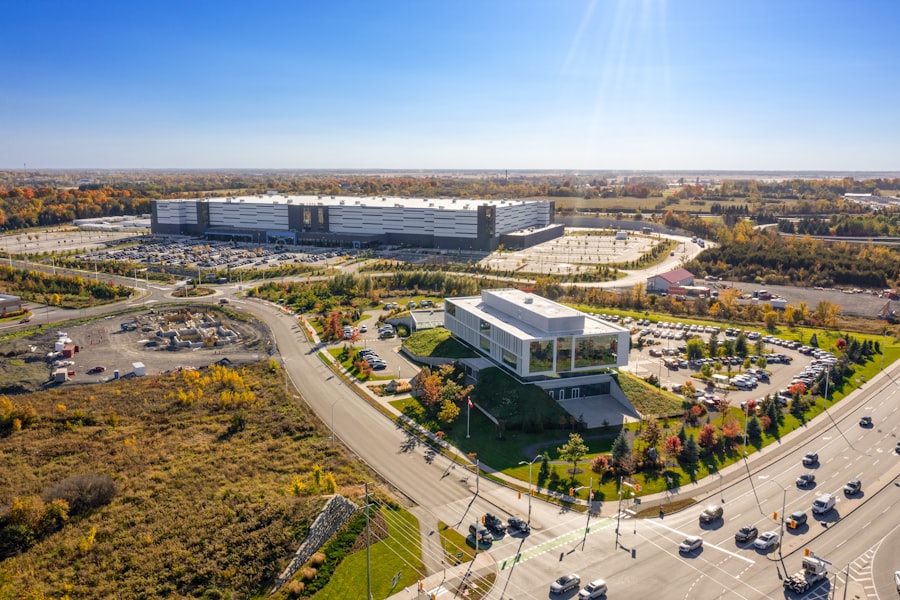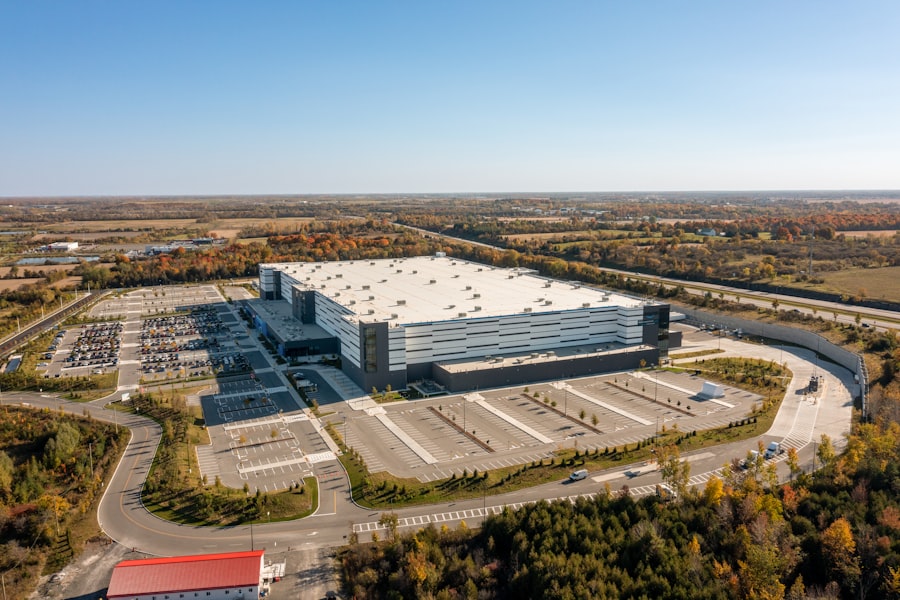The construction industry has long been characterized by its reliance on traditional methods and practices, often resulting in inefficiencies and delays. However, the advent of industrial drones has ushered in a transformative era, revolutionizing how construction projects are planned, executed, and monitored. These unmanned aerial vehicles (UAVs) are equipped with advanced technology, including high-resolution cameras, LiDAR sensors, and GPS capabilities, enabling them to perform a variety of tasks that were once labor-intensive and time-consuming.
As the construction sector increasingly embraces digitalization and automation, industrial drones have emerged as a pivotal tool, enhancing productivity and precision. The integration of drones into construction workflows is not merely a trend; it represents a fundamental shift in operational methodologies. By providing real-time aerial imagery and data collection, drones facilitate better decision-making and project management.
They allow stakeholders to visualize project progress from a bird’s-eye view, enabling more effective communication among teams. As the construction landscape continues to evolve, understanding the role of industrial drones becomes essential for industry professionals seeking to leverage technology for competitive advantage.
Key Takeaways
- Industrial drones are revolutionizing the construction industry by providing efficient and cost-effective solutions for various tasks.
- The use of industrial drones in construction projects offers advantages such as improved safety, enhanced project monitoring, and increased efficiency.
- Industrial drones are being used in construction for applications such as site surveying, progress tracking, and quality control, leading to improved project outcomes.
- Safety and regulatory considerations for industrial drones in construction include compliance with airspace regulations and the implementation of safety protocols.
- The use of industrial drones in construction projects results in significant cost and time savings, making them a valuable asset for the industry.
Advantages of Using Industrial Drones in Construction Projects
One of the most significant advantages of employing industrial drones in construction is their ability to enhance data collection and analysis. Drones can capture high-resolution images and videos of construction sites, providing detailed visual documentation that can be analyzed for various purposes. This capability allows project managers to monitor progress against timelines, assess the quality of work, and identify potential issues before they escalate into costly problems.
The ability to gather comprehensive data quickly and efficiently leads to more informed decision-making and improved project outcomes. Moreover, drones contribute to increased safety on construction sites. Traditional surveying methods often require personnel to work in hazardous environments, exposing them to risks such as falls or equipment accidents.
Drones can perform these tasks remotely, significantly reducing the need for workers to be in potentially dangerous situations.
This shift not only enhances worker safety but also aligns with regulatory requirements aimed at minimizing workplace hazards.
Applications of Industrial Drones in Construction
The applications of industrial drones in construction are diverse and multifaceted, catering to various stages of the construction process. One prominent application is site surveying and mapping. Drones equipped with photogrammetry software can create detailed topographical maps and 3D models of construction sites.
This capability is invaluable during the planning phase, as it allows architects and engineers to visualize the terrain and make informed decisions regarding design and layout. In addition to surveying, drones are increasingly used for monitoring construction progress. By conducting regular aerial inspections, project managers can compare current site conditions with initial plans, ensuring that work is proceeding as scheduled.
This ongoing oversight helps identify discrepancies early on, allowing for timely interventions that can prevent delays and cost overruns. Furthermore, drones can facilitate stakeholder engagement by providing visual updates that can be shared with clients and investors, fostering transparency and trust throughout the project lifecycle.
Safety and Regulatory Considerations for Industrial Drones in Construction
While the benefits of industrial drones in construction are substantial, their use is accompanied by safety and regulatory considerations that must be addressed. The Federal Aviation Administration (FAA) in the United States has established guidelines governing the operation of drones in commercial settings. These regulations include requirements for pilot certification, drone registration, and adherence to specific operational limits such as altitude restrictions and no-fly zones.
Compliance with these regulations is crucial for ensuring safe drone operations and avoiding legal repercussions. Additionally, construction companies must implement safety protocols to mitigate risks associated with drone usage. This includes conducting thorough pre-flight checks to ensure that equipment is functioning correctly and that weather conditions are suitable for flight.
Training personnel on drone operation and safety procedures is also essential to minimize accidents. By fostering a culture of safety and adhering to regulatory standards, construction firms can harness the advantages of drone technology while safeguarding their workforce.
Cost and Time Savings with Industrial Drones in Construction
The financial implications of integrating industrial drones into construction projects are significant. One of the primary ways drones contribute to cost savings is through increased efficiency in data collection and analysis. Traditional surveying methods can take days or even weeks to complete, whereas drones can accomplish similar tasks in a matter of hours.
This reduction in time translates directly into labor cost savings and allows projects to stay on schedule. Moreover, drones help minimize costly errors by providing accurate data that informs decision-making. For example, by identifying potential issues early in the construction process—such as design discrepancies or material shortages—project managers can take corrective action before these problems escalate into expensive delays or rework.
The ability to conduct regular inspections also means that maintenance issues can be addressed proactively, further reducing long-term costs associated with repairs or project overruns.
Case Studies of Successful Implementation of Industrial Drones in Construction Projects
Several case studies illustrate the successful implementation of industrial drones in construction projects across various sectors. One notable example is the use of drones by Skanska USA during the construction of a new hospital in New York City. The company employed drones to conduct aerial surveys that provided real-time data on site progress.
This approach allowed Skanska to identify discrepancies between actual work completed and planned milestones, enabling timely interventions that kept the project on track. Another compelling case is that of Turner Construction Company, which utilized drones for a large-scale infrastructure project involving the renovation of a major airport terminal. By employing drones for site inspections and progress monitoring, Turner was able to enhance communication among stakeholders and provide visual updates that kept clients informed throughout the project lifecycle.
The use of drones not only improved efficiency but also fostered collaboration among teams, ultimately leading to successful project completion ahead of schedule.
Future Trends and Developments in Industrial Drones for Construction
As technology continues to advance, the future of industrial drones in construction looks promising. One emerging trend is the integration of artificial intelligence (AI) with drone technology. AI algorithms can analyze data collected by drones to identify patterns and anomalies that may not be immediately apparent to human observers.
This capability could enhance predictive maintenance efforts, allowing construction firms to address potential issues before they impact project timelines or budgets. Additionally, advancements in drone autonomy are expected to play a significant role in shaping the future landscape of construction. Fully autonomous drones capable of performing complex tasks without human intervention could streamline workflows even further.
For instance, drones could autonomously conduct routine inspections or deliver materials directly to job sites, reducing reliance on manual labor and increasing overall efficiency.
The Impact of Industrial Drones on the Construction Industry
The impact of industrial drones on the construction industry is profound and far-reaching. By enhancing data collection capabilities, improving safety measures, and driving cost efficiencies, drones have become an indispensable tool for modern construction practices. As the industry continues to embrace technological advancements, the role of drones will likely expand further, paving the way for innovative applications that enhance productivity and project outcomes.
The ongoing evolution of drone technology promises exciting possibilities for the future, ensuring that the construction industry remains at the forefront of innovation while addressing the challenges of an ever-changing landscape.
In the rapidly evolving world of construction, industrial drones are playing a pivotal role in optimizing project efficiency and safety. These advanced drones are equipped with high-resolution cameras and sensors, enabling real-time data collection and analysis, which significantly enhances project management and decision-making processes. As construction companies increasingly adopt this technology, they are witnessing reduced costs and improved timelines. For those interested in the technological advancements shaping various industries, the article on What is Special About the iPhone 14 Pro provides insights into the cutting-edge features of the latest iPhone, showcasing how innovation continues to drive progress across different sectors.
FAQs
What are industrial drones?
Industrial drones are unmanned aerial vehicles (UAVs) that are specifically designed and equipped for industrial applications, such as construction, agriculture, mining, and infrastructure inspection. These drones are equipped with advanced sensors, cameras, and software to perform various tasks in industrial settings.
How do industrial drones optimize construction projects?
Industrial drones optimize construction projects by providing real-time aerial surveys, 3D mapping, and progress tracking. They can also be used for site inspections, safety monitoring, and inventory management. Drones help improve efficiency, reduce costs, and enhance safety on construction sites.
What are the benefits of using industrial drones in construction projects?
The benefits of using industrial drones in construction projects include improved project planning, faster and more accurate surveying, reduced risk to workers, and better resource management. Drones also enable better communication and collaboration among project teams and stakeholders.
What types of construction tasks can industrial drones perform?
Industrial drones can perform a wide range of construction tasks, including site surveying, progress monitoring, volume measurements, thermal imaging, and aerial photography. They can also be used for inspecting hard-to-reach or hazardous areas, as well as for creating digital elevation models and topographic maps.
Are there any regulations or restrictions for using industrial drones in construction projects?
Yes, there are regulations and restrictions for using industrial drones in construction projects, which vary by country and region. These may include obtaining permits or licenses, adhering to flight altitude and distance limits, and following privacy and safety guidelines. It is important for construction companies to be aware of and comply with these regulations when using drones.



